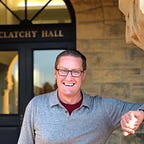Plan B for local news: How B Corporations present an opportunity for media
One of the many things individuals and groups who want to launch enterprises in the local news space have to consider is a tax structure. It starts with the decision between for- and non-profit, but beyond that it can devolve into a maze of letters, numbers and symbols: LLC, S Corp, 501(c)(3), DBA and more.
But an emerging new structure could hold signifiant potential for local media entrepreneurs: The B Corporation.
A B Corp is a for-profit entity; the B stands for benefit. The idea is to build businesses that benefit not just their shareholders, but any stakeholder that may interact with the business and its products or services. The concept breaks down into two pieces — a tax status as well as a certification from an independent entity known as B Lab.
The B Lab process is a certification that requires a scoring process based upon many factors, as well as an interview and commitment towards social consciousness. It grants a status and glow to a business that says they care about making a positive impact. Separately, a growing number of states allow businesses to form as a legal entity known as a public benefit corporation requiring owners to “consider employees, community and the environment when making decisions, rather than being beholden solely to profits,” according to Entrepreneur magazine.
Several big companies have taken the B Corp leap — Patagonia, Ben & Jerry’s and Warby Parker among them.
Russ Stoddard, owner of Boise-based advertising agency Oliver Russel wrote the book on socially conscious business and the B Corp movement. Literally — his tome Rise Up: How to Build a Socially Conscious Business walks through the entire process from beginning to end.
He looks at business through the lens of social responsibility — not to diminish the competitive drive or need for profit, but instead to look as business at something that can also serve the greater good. In his book, here’s how Stoddard defines this vein of enterprise:
“Social enterprises intentionally integrate purpose, social impact and public benefit into a business model that also creates financial profit.”
In many ways, the effort to meet the information needs of a community is the ultimate public benefit — helping to bring news and coverage to a geographic or other community to help them make better decisions and be better informed.
“It can be a good differentiator in the market,” Stoddard told me. He converted his ad agency to a B Corp in 2012. “At first we were an oddity, but now more people understand and it has helped us to improve our match with purpose-driven organizations.”
For the most part, local news operations have chosen a traditional for-profit structure or non-profit route. A few media operations are using this model — including Greater Richmond (Virginia) Grid Magazine.
Stoddard agrees the B Corp model could be a fit for local news.
“News sites understand their community. Localism matters, and the heart of a community is the people who live there.”
A B Corp for local news could give the brand a glow and help the organization make a statement about what it believes in. It may even help attract investment and advertisers that buy into the concept that journalism is about people — helping them lead better lives, hold their leaders accountable and understand what is going on around them.
Know of anyone considering how to use B Corp for local news? I’d like to hear about it; reach out to me at donday@stanford.edu.
Don Day is a 2018 Stanford John S. Knight Fellow. He has twenty years experience in media — leading teams, producing award-winning journalism and innovating in the digital journalism space. He currently is the publisher of BoiseDev.com.
